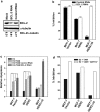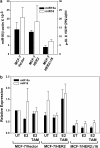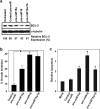Oncogenic HER2{Delta}16 suppresses miR-15a/16 and deregulates BCL-2 to promote endocrine resistance of breast tumors
- PMID: 20876285
- PMCID: PMC2994280
- DOI: 10.1093/carcin/bgq192
Oncogenic HER2{Delta}16 suppresses miR-15a/16 and deregulates BCL-2 to promote endocrine resistance of breast tumors
Abstract
Tamoxifen is the most commonly prescribed therapy for patients with estrogen receptor (ER)α-positive breast tumors. Tumor resistance to tamoxifen remains a serious clinical problem especially in patients with tumors that also overexpress human epidermal growth factor receptor 2 (HER2). Current preclinical models of HER2 overexpression fail to recapitulate the clinical spectrum of endocrine resistance associated with HER2/ER-positive tumors. Here, we show that ectopic expression of a clinically important oncogenic isoform of HER2, HER2Δ16, which is expressed in >30% of ER-positive breast tumors, promotes tamoxifen resistance and estrogen independence of MCF-7 xenografts. MCF-7/HER2Δ16 cells evade tamoxifen through upregulation of BCL-2, whereas mediated suppression of BCL-2 expression or treatment of MCF-7/HER2Δ16 cells with the BCL-2 family pharmacological inhibitor ABT-737 restores tamoxifen sensitivity. Tamoxifen-resistant MCF-7/HER2Δ16 cells upregulate BCL-2 protein levels in response to suppressed ERα signaling mediated by estrogen withdrawal, tamoxifen treatment or fulvestrant treatment. In addition, HER2Δ16 expression results in suppression of BCL-2-targeting microRNAs miR-15a and miR-16. Reintroduction of miR-15a/16 reduced tamoxifen-induced BCL-2 expression and sensitized MCF-7/HER2Δ16 to tamoxifen. Conversely, inhibition of miR-15a/16 in tamoxifen-sensitive cells activated BCL-2 expression and promoted tamoxifen resistance. Our results suggest that HER2Δ16 expression promotes endocrine-resistant HER2/ERα-positive breast tumors and in contrast to wild-type HER2, preclinical models of HER2Δ16 overexpression recapitulate multiple phenotypes of endocrine-resistant human breast tumors. The mechanism of HER2Δ16 therapeutic evasion, involving tamoxifen-induced upregulation of BCL-2 and suppression of miR-15a/16, provides a template for unique therapeutic interventions combining tamoxifen with modulation of microRNAs and/or ABT-737-mediated BCL-2 inhibition and apoptosis.
Figures






Similar articles
-
MicroRNA-7 inhibits multiple oncogenic pathways to suppress HER2Δ16 mediated breast tumorigenesis and reverse trastuzumab resistance.PLoS One. 2014 Dec 22;9(12):e114419. doi: 10.1371/journal.pone.0114419. eCollection 2014. PLoS One. 2014. PMID: 25532106 Free PMC article.
-
Downregulation of miR-342 is associated with tamoxifen resistant breast tumors.Mol Cancer. 2010 Dec 20;9:317. doi: 10.1186/1476-4598-9-317. Mol Cancer. 2010. PMID: 21172025 Free PMC article.
-
An oncogenic isoform of HER2 associated with locally disseminated breast cancer and trastuzumab resistance.Mol Cancer Ther. 2009 Aug;8(8):2152-62. doi: 10.1158/1535-7163.MCT-09-0295. Epub 2009 Aug 11. Mol Cancer Ther. 2009. PMID: 19671734
-
Epidermal growth factor receptor/HER2/insulin-like growth factor receptor signalling and oestrogen receptor activity in clinical breast cancer.Endocr Relat Cancer. 2005 Jul;12 Suppl 1:S99-S111. doi: 10.1677/erc.1.01005. Endocr Relat Cancer. 2005. PMID: 16113104 Review.
-
Inhibition of erbB receptor (HER) tyrosine kinases as a strategy to abrogate antiestrogen resistance in human breast cancer.Clin Cancer Res. 2001 Dec;7(12 Suppl):4436s-4442s; discussion 4411s-4412s. Clin Cancer Res. 2001. PMID: 11916237 Review.
Cited by
-
Examining the evidence for mutual modulation between m6A modification and circular RNAs: current knowledge and future prospects.J Exp Clin Cancer Res. 2024 Aug 3;43(1):216. doi: 10.1186/s13046-024-03136-2. J Exp Clin Cancer Res. 2024. PMID: 39095902 Free PMC article. Review.
-
miRNA clusters as therapeutic targets for hormone-resistant breast cancer.Expert Rev Endocrinol Metab. 2015;10(6):607-617. doi: 10.1586/17446651.2015.1099430. Epub 2015 Oct 13. Expert Rev Endocrinol Metab. 2015. PMID: 27721895 Free PMC article.
-
MicroRNAs in pathogenesis of breast cancer: Implications in diagnosis and treatment.World J Clin Oncol. 2014 May 10;5(2):48-60. doi: 10.5306/wjco.v5.i2.48. World J Clin Oncol. 2014. PMID: 24829851 Free PMC article. Review.
-
Non-Coding RNAs Modulating Estrogen Signaling and Response to Endocrine Therapy in Breast Cancer.Cancers (Basel). 2023 Mar 7;15(6):1632. doi: 10.3390/cancers15061632. Cancers (Basel). 2023. PMID: 36980520 Free PMC article. Review.
-
Resistance to cancer chemotherapeutic drugs is determined by pivotal microRNA regulators.Am J Cancer Res. 2017 Jun 1;7(6):1350-1371. eCollection 2017. Am J Cancer Res. 2017. PMID: 28670496 Free PMC article.
References
Publication types
MeSH terms
Substances
LinkOut - more resources
Full Text Sources
Other Literature Sources
Medical
Research Materials
Miscellaneous

